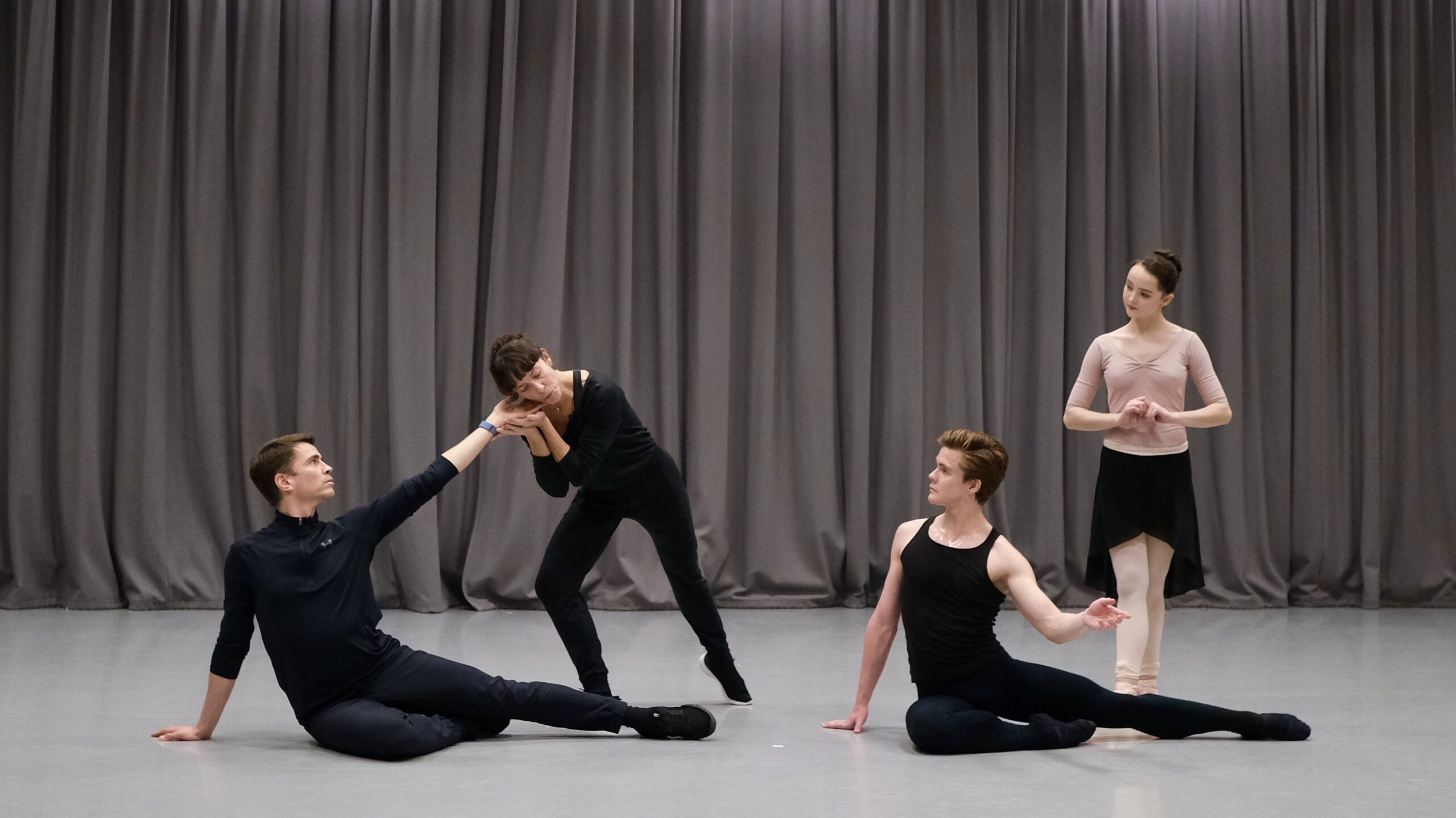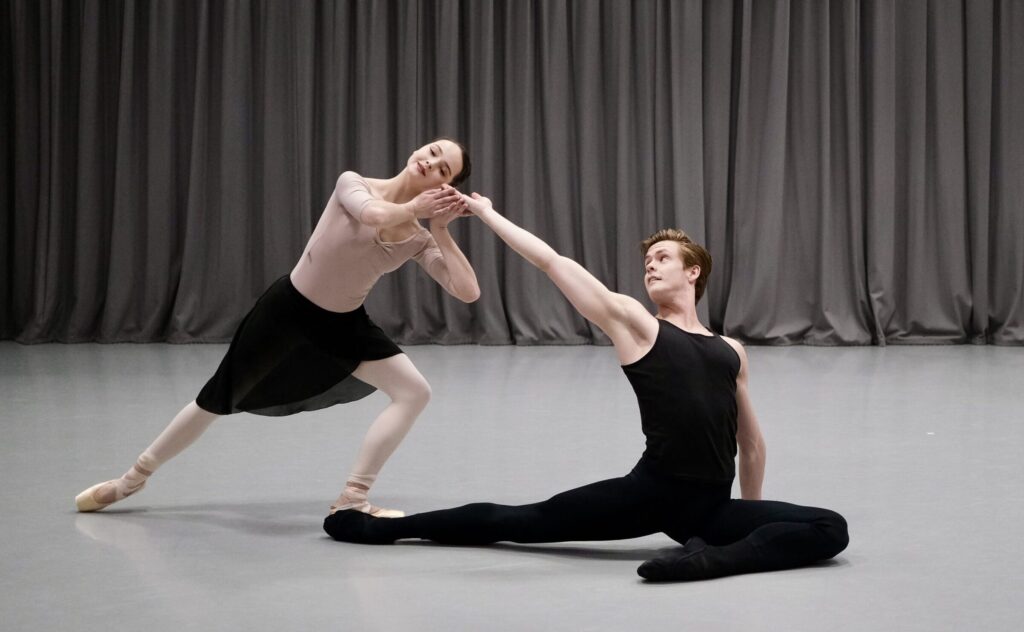Ella Newton Severgnini and Harrison Lee (The Royal Ballet) dancing a pas de deux from Ashton’s The Devil’s Holiday during an Ashton Rediscovered masterclass, February 2025 ©The Frederick Ashton Foundation. Ph Rachel Thomas.
by Jane Pritchard, taken from her introduction to the ‘Ashton Rediscovered’ masterclass on 23 February 2025
The Devil’s Holiday (1939), the focus of the Frederick Ashton Foundation’s masterclass on Sunday 23 February 2025, was Ashton’s first commission for an international company – the Ballet Russe de Monte Carlo. It was the second of his works to be premiered in the USA, following Four Saints in Three Acts (1934), and the one ballet he choreographed that he never saw in performance. Its creation, just as War broke out in 1939 – and the resulting working conditions – in part accounts for its short life in performance but, thankfully, sections were filmed in rehearsal. (Léonide Massine, choreographer of the Ballet Russe de Monte Carlo, was something of a pioneer in using film to record works for reference purposes.) Sight of these fragments of film jogged the memory of dancer and ballet master Frederic Franklin who, at the very end of his life, restaged his own solo and the pas de deux created for Alexandra Danilova and himself.
It appears that Ashton was the third choice of choreographer to create The Devil’s Holiday. Initially it was commissioned for Massine and, when he had too many other ballets to complete, it was offered to George Balanchine. At his refusal, Ashton was invited to choreograph the production, for which the narrative, the music by Vincenzo Tommasini on themes by Niccolò Paganini and the designs by neo-romantic artist Eugene Berman were already created.
Ashton choreographed the ballet in France in just two weeks, with Alexandra Danilova as ‘the daughter of an old lord’ and Franklin as ‘her lover’. The role of the Devil was entrusted to Marc Platoff. Ashton chose to work with Danilova rather than his friend (and second cast ballerina) Alicia Markova because it gave him the opportunity to learn from the great Russian ballerina. She appears to have had little to say about the role, and seemed bemused by Ashton’s request to ‘show him something’ – a phrase or movement idea – that he would adapt into original choreography; a way of working she was unused to.
The ballet had been intended to have its first performance in London during the season by the Ballet Russe de Monte Carlo, but theatres closed with the outbreak of War. The dancers raced across the Atlantic, with some of them arriving in New York on the day of the first performance of The Devil’s Holiday at the Metropolitan Opera House, 26 October 1939. Thus, after a nerve-wracking crossing, it was straight into performance with no time for proper stage rehearsal, and without the presence of the choreographer. As Musical America noted, it had been a ‘desperate scramble to get the company together’—but the season was launched with its customary ‘éclat’ even if the ensemble in the new work ‘showed traces of raggedness’.
Ashton’s biographer, David Vaughan, observed that The Devil’s Holiday was both a ballet of atmosphere and grand spectacle, and critic Edwin Denby, whose review was written after seeing several performances, described it as a ballet ‘full of zest, sincerity, freshness and charm’. It was a multi-scene, 40 minute-long ballet and designer, Berman – an artist who was just emerging as a scenic artist and loved Italy – infused its designs with Italian architectural details to give it a sense of place and atmosphere. Between set pieces there were entr’actes, with Paganini perched on a tombstone playing his violin against a night sky of clouds (Paganini ballets were in fashion in the late 1930s), and the final scene left a strong impression with most viewers. Its set was ‘a glowing scene of the Venetian piazza with its Palladian architecture crowned by gymnastic statuary and sumptuous azure ducal banners. The costumes and masks were most inventive in grotesqueries: the beggars, the wood gatherers, the vegetable vendors, the wandering minstrels of Berman’s easel painting came to life.’ Denby thought the dancing particularly in this last scene was ‘splendid’. It was ‘a whirl of inventions, of young eagerness that can hardly stop for the tenderness it dreams of, and that is tender without knowing it. A choreographer who can call up so many sincere emotions, who keeps a steady line of increasing interest (and animation) throughout a long ballet, and does not fall into conventional tags at important moments, is a real rarity who is worth being enthusiastic about.’ The farandole in the last scene was described as like ‘a fashion show in heaven’—and indeed the production did inspire fashions on New York that season.

Ricardo Cervera and Laura Morera coaching Ella Newton Severgnini and Harrison Lee (The Royal Ballet) in a pas de deux from Ashton’s The Devil’s Holiday during an Ashton Rediscovered masterclass, February 2025 ©The Frederick Ashton Foundation. Ph Rachel Thomas.
Frederic Franklin first reconstructed his two dances from The Devil’s Holiday for dancers of Cincinnati Ballet in 2002. He then mounted the duet (a tender ‘conversation’ not a conventional pas de deux) on Laura Morera and Ricardo Cervera, and the lyrical and challenging male solo on Viacheslav Samodurov. They were first danced in The Royal Ballet’s divertissement section of the Ashton 100 Celebrations programme in 2004 (during this run the pas de deux was also danced by Martin Harvey, Isabel McMeekan and Viacheslav Samodurov). The final performance of the run was later recorded for television and is commercially available on DVD. Berman’s original costumes were modified by Allan Watkins, retaining their trails of ivy.
Liverpool-born Franklin, who was into his 90s and still performing when he reconstructed these dances, had a phenomenal memory, which was stirred by seeing the footage and hearing the score. He wrote, ‘It was my good fortune at that time to have been chosen to dance the lead in one of Fred’s most beautiful ballets.’ As has been noted, the choreography was unlike roles Ashton would create on contemporary British danseurs, emphasising the lyrical aspects of the art so appropriate for what is essentially a neo-romantic ballet.
Watch the Devil’s Holiday Ashton Rediscovered masterclass on YouTube
Jane Pritchard MBE is Curator of Dance for the Victoria and Albert Museum, London, and one of the most distinguished British historians of dance. She has held positions as archivist of Rambert Dance Company and English National Ballet, and has written widely on the Ballets Russes and on 19th- and 20th-century dance.

